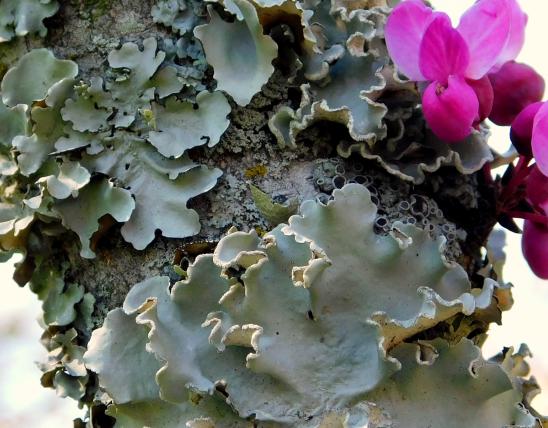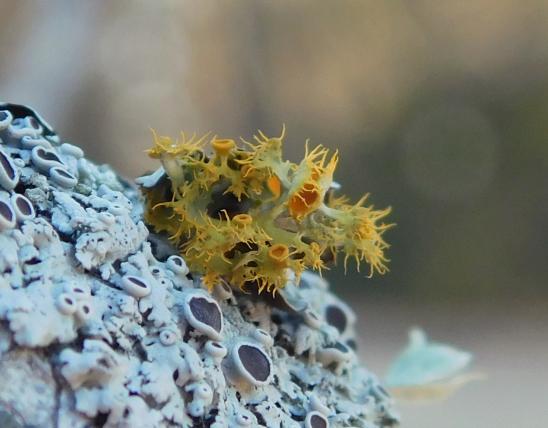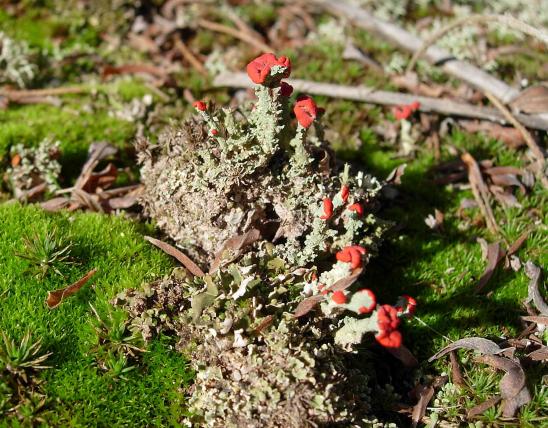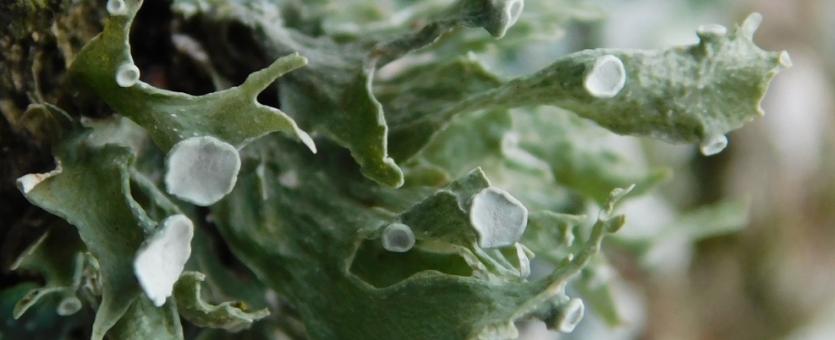
Missouri has two species of twig lichens, or strap lichens (genus Ramalina). At a glance, they look like beard lichens, since they grow in shrubby, gray-green tufts and attach to the substrate at a single point. Unlike beard lichens, however, they have flattened, straplike branches. The apothecia (spore-bearing structures) are disk-shaped and usually paler than the rest of the lichen.
Like other fruticose lichens, or shrubby lichens, Ramalina species are three-dimensional instead of having flattened leafy or crusty forms. Other fruticose lichens may look quite different, but they all lack a distinctive top, middle, and lower layer, since they are like little shrubs or trees.
A lichen is an organism that results when a fungus species and an algae species join together. Although the relationship between the fungi and algae is quite intimate and integrated, the lichen that is formed does not much resemble either of the components. Learn more about lichens on their group page.
Globally, this genus is large and diverse, but only two species of Ramalina have been recorded for Missouri. One is very common, and the other is quite rare:
- Sinewed ramalina, or American cartilage lichen (R. americana), is by far the most common in our state. It has dull surfaces that look veined or pitted; it usually grows on the bark of tree trunks and branches. The apothecia are circular, about the same color as the thallus or paler. It is common on nursery trees, so you may find it in landscape plantings in cities, on golf courses, in cemeteries, on college campuses, and in office parks.
- Rock ramalina (R. intermedia) is a species of conservation concern in Missouri and is critically imperiled in our state. In North America, the species is most abundant in the Great Lakes and Appalachian regions. Its flattened stalks look knobby and have shiny surfaces; also, tiny, nubby soredia (fragments that break off to form new lichens) form in granular clusters at the branch tips. It usually grows only to about 1 inch high, but it can form colonies covering large areas of sandstone escarpments: It grows on rock faces, not on trees. Apparently, in our state, it occurs in only two locations in the southeast Missouri Ozarks.
Similar species:
- Missouri has several species of shrubby lichens called beard lichens (Usnea spp.). At a glance, these look like twig lichens, since they, too, grow in shrubby pale green tufts. Unlike twig lichens, however, the branches of beard lichens are fibrous-looking and round in cross-section, instead of being flattened or straplike.
- Gold-eye lichen (Teloschistes chrysophthalmus) also typically grows in tufts on branches. Although the thallus (main body) may be grayish green, it is usually at least tinged with yellow, especially near the cup-shaped fruiting structures. These apothecia cups are bright orange or yellow, and the rim of each is often surrounded by a thin rim the color of the thallus, usually with bristles radiating outward from the rim like eyelashes. This is a very attractive lichen, even though each tuft is usually only about half an inch high.
Height: tufts usually about ½ inch; sometimes to 1 inch.
Sinewed ramalina (R. americana) occurs statewide. Rock ramalina (R. intermedia) is only found in a few locations in southeast Missouri.
Habitat and Conservation
Sinewed ramalina (R. americana), Missouri's common species of twig lichen, grows on tree trunks and branches. Rock ramalina (R. intermedia), as mentioned above in the Description section, is rare in our state; here, it is known only from sandstone escarpments in two locations in the southeast Missouri Ozarks.
Fruticose lichens are some of the first to disappear when a natural habitat is disrupted. Air pollution harms many lichens.
Status
Sinewed ramalina (R. americana) is quite common. Rock ramalina (R. intermedia), as mentioned above in the Description section, is rare in our state and is classified as a species of conservation concern.
Human Connections
Humans transport lichens such as sinewed ramalina across the continent when nursery trees and shrubs are shipped from one place to another. This makes it tricky for biologists to determine if an occurrence of the lichen species is native to a state or region, or not.
There are many more species of Ramalina lichens in North American and globally. The West Coast, the Pacific Northwest, and the southeastern coastal states including Florida, with their moist climates, have many strap lichen species that don’t occur here. When you travel, keep an eye out for these relatives!
Ecosystem Connections
Some species of flying squirrels build nests out of fruticose lichens, including twig lichens. Several types of birds decorate the outsides of their nests with lichens, which helps camouflage them on tree branches.
Because many lichens provide cover for several types of insects, insect-eating animals often focus their hunting on lichen-covered places on trim limbs and trunks. Birds that forage for insects among lichens include nuthatches, the brown creeper, chickadees, titmice, woodpeckers, and numerous vireos and warblers. Other animals that look for insect prey among lichens include several types of spiders and the larvae of green lacewings.
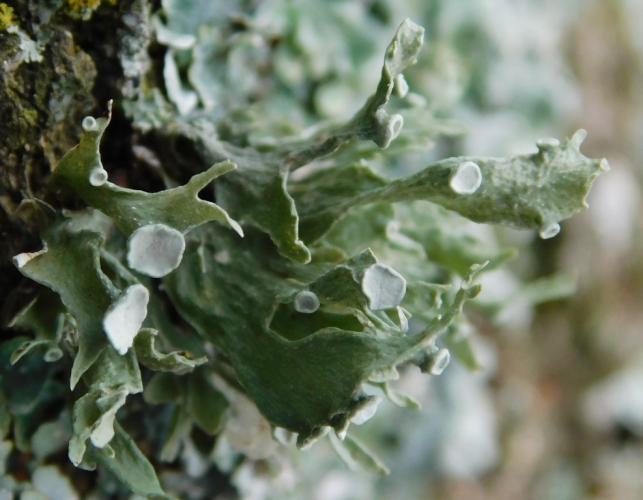
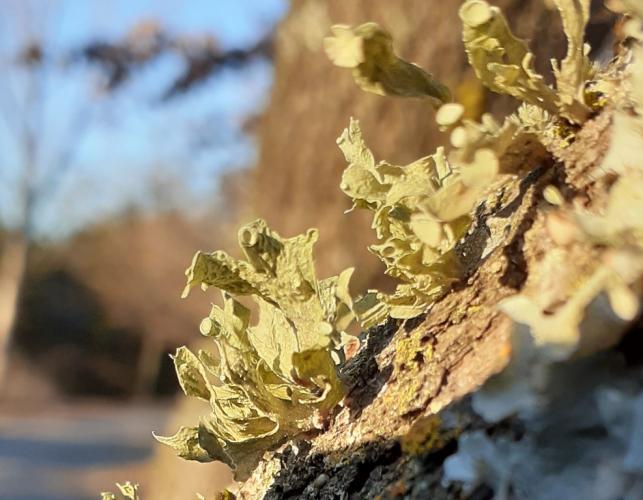
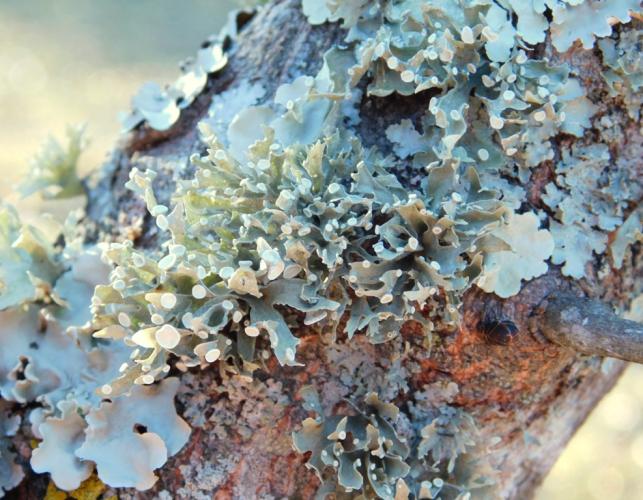
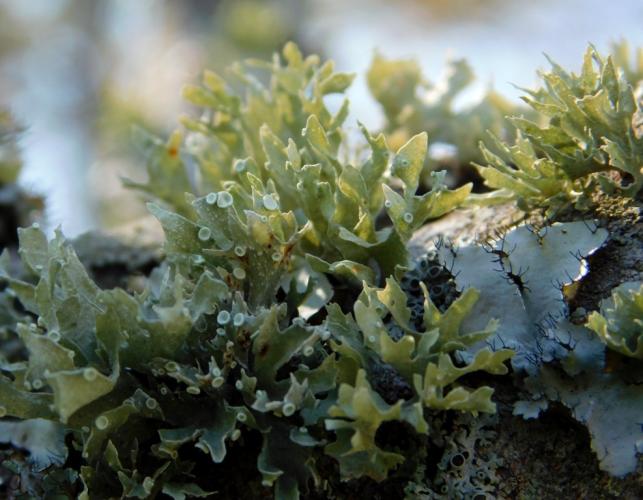
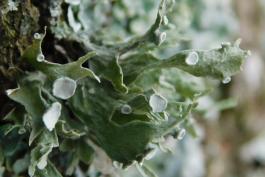
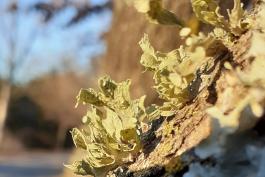
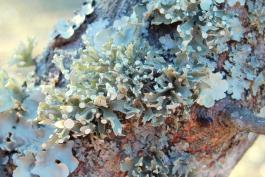
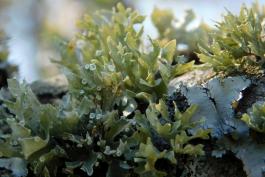
Mosses, liverworts, hornworts, and lichens seem rather similar, but these organisms are in very different groups. Mosses, liverworts, and hornworts are small, low plants usually found in damp habitats. Unlike more familiar plants, they lack veinlike structures and do not produce flowers or seeds — instead, they produce spores. Meanwhile, lichens are not plants at all: they are a collection of different fungi that have photosynthetic algae living within their tissues.






















